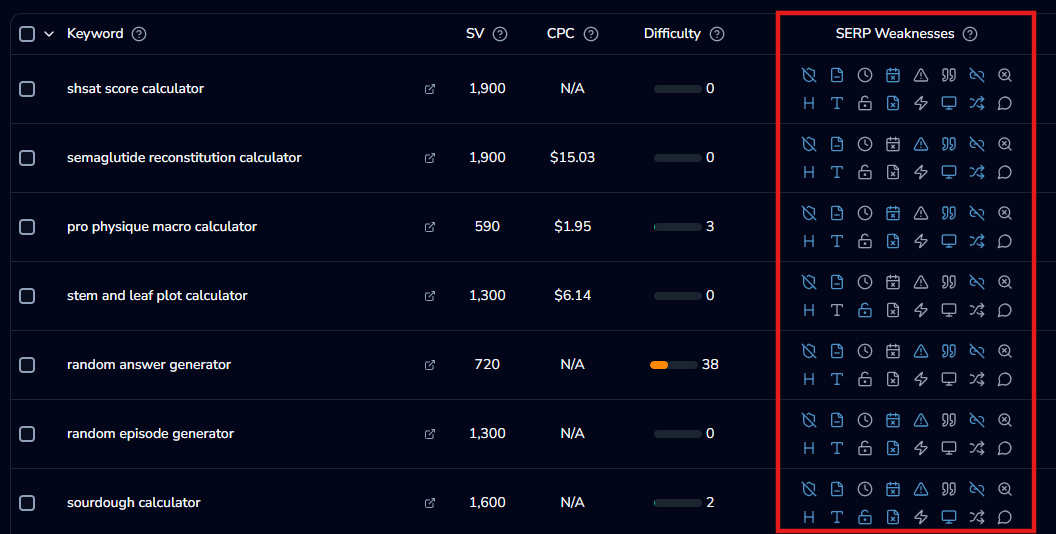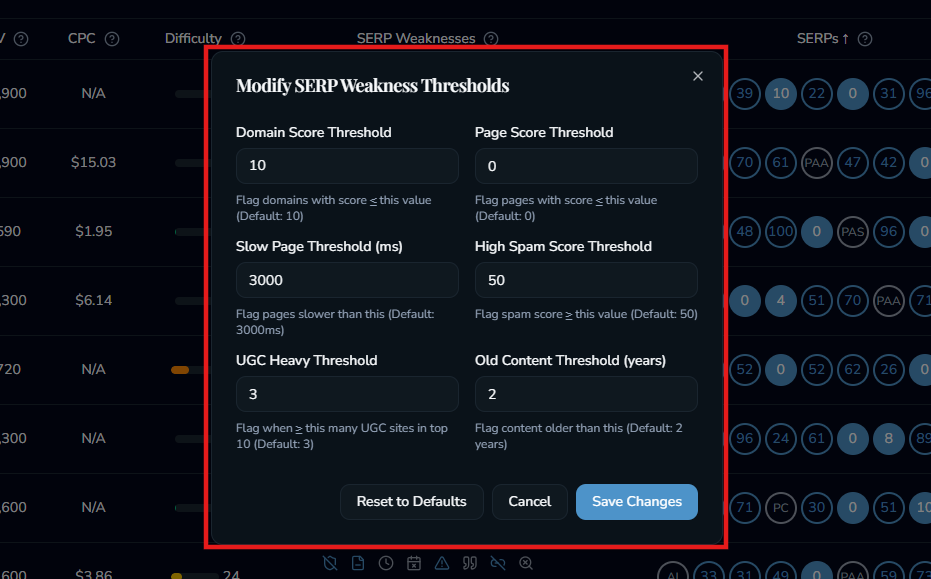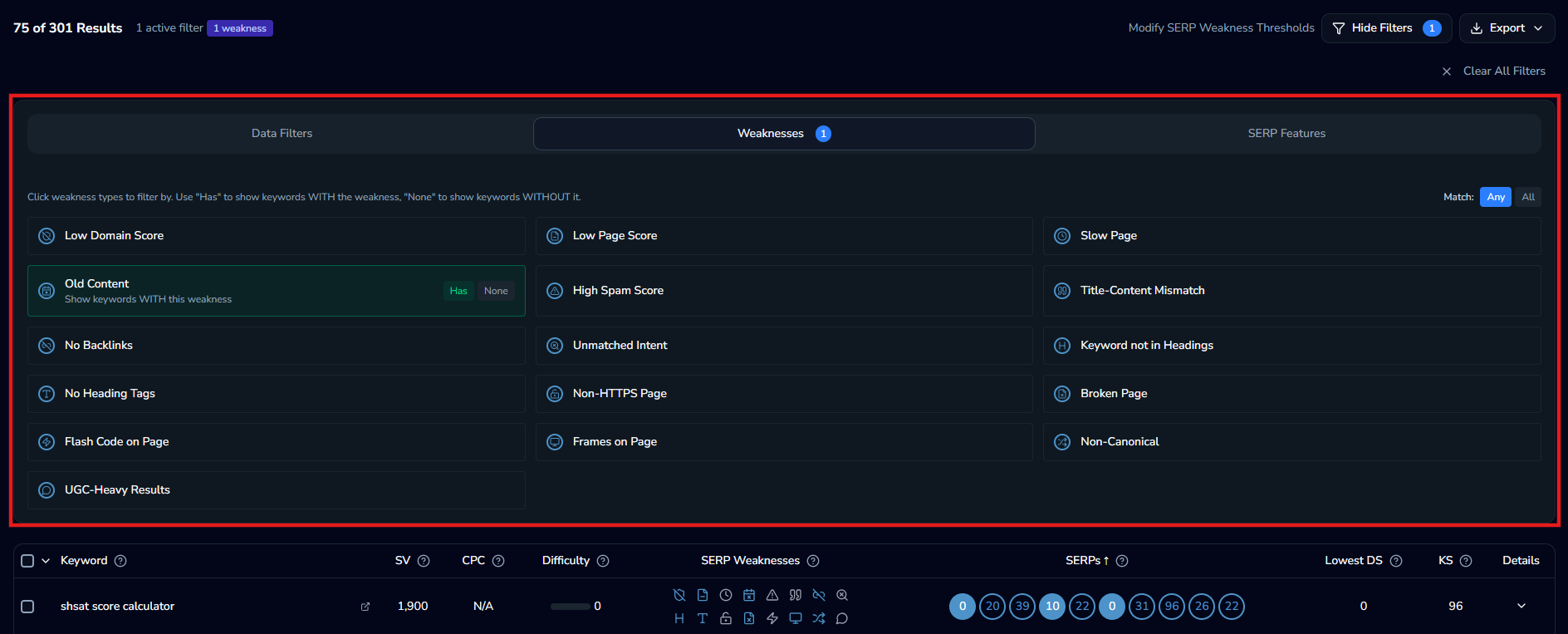SERP weakness detection is the core feature that sets ClearSERP apart. By analyzing specific vulnerabilities in search results, you can identify keywords where you have the best chance to rank and outcompete existing results.

How Weakness Detection Works
ClearSERP analyzes the top 10 organic search results for each keyword and identifies various signals that indicate ranking opportunities. The analysis combines multiple data sources:
- Domain Score Analysis: Calculating domain authority and strength metrics
- Page Score Analysis: Individual page authority measurements
- Technical Analysis: Page speed, security, and technical SEO factors
- Content Freshness Analysis: Last modified dates and content age
- SERP Feature Analysis: User-generated content detection and intent matching
- Backlink Analysis: Link profile strength and quality assessment
Complete List of Detected Weaknesses
ClearSERP detects 17 different types of weaknesses across 4 main categories. Each weakness represents a specific opportunity where you can potentially outrank existing results.
Domain & Authority Weaknesses
Low Domain Score
Competitors with Domain Score ≤ 10 (default threshold). Domain Score measures overall domain authority and strength. Lower scores indicate weaker domains that can be outranked.
Low Page Score
Individual pages with Page Score ≤ 0 (default threshold). Page Score measures the authority of specific pages rather than entire domains.
No Backlinks
Pages ranking with exactly 0 backlinks indicate that link building may not be essential for this keyword. These represent opportunities for quality content without extensive link building.
Technical SEO Weaknesses
Slow Page Speed
Pages with load times under 3000ms (3 seconds) by default. Measured using advanced page performance analysis with actual page load timing data.
High Spam Score
Domains with spam scores ≥ 50 (default threshold) show strong signs of being spammy, and may be easier to outrank with a clean, legitimate website. You can learn more about Spam Score here.
Non-HTTPS Page
Pages still using HTTP instead of HTTPS, indicating outdated security practices.
Broken Page
Pages returning 4xx or 5xx status codes, indicating technical issues.
Flash Code on Page
Pages still using outdated Flash technology, which is no longer supported by modern browsers.
Frames on Page
Pages using HTML frames, an outdated and SEO-unfriendly technology.
Non-Canonical
Pages without proper canonical URL implementation, indicating potential duplicate content issues.
Content Quality Weaknesses
Old Content
Content that hasn't been updated in over 2 years (default threshold). Detected using last modified dates from technical analysis. Fresh content often outranks stale information.
Title-Content Mismatch
Pages where the title tag doesn't accurately reflect the page content, indicating poor optimization or misleading information.
Keyword Not in Headings
Pages that don't include the target keyword in any H1-H6 heading tags, suggesting suboptimal content structure for SEO.
No Heading Tags
Pages without any HTML heading tags (H1-H6), indicating poor content structure and organization.
Unmatched Intent
When ranking page titles don't contain the main words from the search keyword, suggesting the content may not fully match user search intent.
SERP Composition Weaknesses
UGC-Heavy Results
When 3+ results (default threshold) in the top 10 are from user-generated content sites like Reddit, Quora, StackOverflow, or forum discussions. The presence of UGC content is no longer considered a SERP weakness by most SEOs (since Google's September 2023 Helpful Content Update). However, it is still tracked by ClearSERP since it can be useful to know if a the SERPs are dominated by UGC content.
Understanding Keyword Scores
Each keyword receives a Keyword Score (0-100) calculated using an exponential scaling algorithm that considers all detected weaknesses plus additional factors:
Scoring Components
- Standard Weaknesses: 1 point each for the 13 standard weaknesses listed above
- Unmatched Intent: 4 points for 1 missing word, 7 points for 2+ missing words
- Search Volume Bonus: +1 to +3 points based on volume tiers (101-1000, 1001-5000, 5000+)
- Keyword Difficulty Bonus: +3 for difficulty 0, +2 for 1-15, +1 for 15-30
- Average Domain Score: Variable bonus when competitors have low average domain scores
- Individual Low Domain Scores: Position-weighted bonuses for very low domain scores
- SERP Features Penalty: -1 point per non-organic feature in top 10 (max -3)
Score Interpretation
- 90-100: Exceptional opportunity - multiple significant weaknesses detected
- 70-89: Strong opportunity - several exploitable weaknesses
- 50-69: Moderate opportunity - some weaknesses present
- 30-49: Challenging - few weaknesses, stronger competition
- 0-29: Very difficult - minimal weaknesses, highly competitive
Customizing Detection Thresholds
All weakness detection thresholds can be customized in real-time. The default thresholds are:
Domain Score Threshold: 10 (default)
Page Score Threshold: 0 (default)
Old Content: 2 years (default)
Slow Page: 3000ms (default)
Spam Score: 50 (default)
UGC Heavy: 3 sites (default)To customize thresholds:
- Go to any Analysis results page (current analysis, history, or saved collections)
- Click the Modify SERP Weakness Thresholds link above the results table
- Adjust thresholds in the configuration modal
- Click "Save Changes" to update the analysis in real-time
- Use "Reset to Defaults" to restore original values

Strategic Usage Tips
For New Sites (Low Domain Authority)
Focus on keywords with multiple authority-based weaknesses: Low Domain Score, Low Page Score, and No Backlinks. These indicate opportunities where content quality and optimization matter more than domain strength.
Recommended filters: Include "Low Domain Score" + "No Backlinks" + high Keyword Scores (70+)
For Established Sites (Medium-High Domain Authority)
Target keywords with technical and content weaknesses. Your domain authority gives you an advantage when competing against sites with poor technical SEO or outdated content.
Recommended filters: Include "Old Content" + "Slow Page Speed" + "Technical" weaknesses
For Local SEO
Focus on keywords without Local Pack SERP features but with clear local intent. Filter by SERP features to exclude keywords that already show local packs.
Advanced Filtering by Weaknesses
The filtering system allows you to find keywords with specific weakness combinations:
- Click "Filters" in any analysis results table
- Go to the "Weaknesses" tab
- Select specific weaknesses you want to target
- Choose "Include" mode to show only keywords WITH these weaknesses
- Choose "Exclude" mode to hide keywords with these weaknesses
- Use "Match Type": "Any" to find keywords with ANY selected weakness, "All" for ALL weaknesses
- Apply filters to see matching keywords
